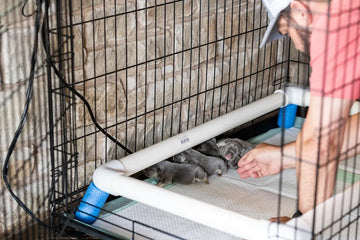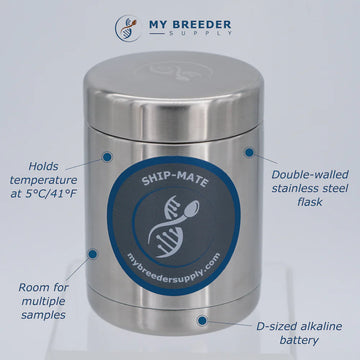
The world of canine breeding has been revolutionized by the introduction of artificial insemination (AI) rods. These innovative tools are not just changing the way breeders approach the breeding process, but they are also enhancing the success rates and overall health of the dogs involved.
This article delves into the significant role AI rods play in canine breeding, exploring their benefits, challenges, and the future of this technology in the breeding world.
Understanding AI Rods

AI rods are essentially instruments used in artificial insemination, a process where semen is collected from a male dog and artificially introduced into the female reproductive tract.
This method is particularly beneficial for breeding dogs that are physically separated by distance, have compatibility issues, or face health risks with natural mating.
The primary aim is to ensure a higher success rate of pregnancy while maintaining genetic diversity.
The Role of AI Rods in Canine Breeding
AI rods have become indispensable in modern canine breeding due to their ability to enhance genetic diversity and reduce health risks associated with inbreeding.
This technology enables breeders to select from a wider gene pool, ensuring the propagation of desirable traits and reducing the likelihood of hereditary diseases.
AI rods make the breeding process less stressful for dogs, as it eliminates the need for physical mating, which can sometimes lead to injuries or transmit diseases.
Comparative Analysis
When comparing traditional breeding methods with AI-assisted techniques, the latter offers a clear advantage in terms of success rates and efficiency.
Traditional breeding methods are often hit-or-miss and can be limited by geographical constraints and the physical condition of the dogs.
In contrast, AI rods allow for a more controlled and precise approach, increasing the likelihood of successful conception.
Technological Advancements in AI Rods
These developments include more accurate detection of optimal breeding times, improved semen preservation techniques, and enhanced tools for semen delivery.
Expert Opinions
Veterinarians and professional breeders generally view the use of AI rods in canine breeding favorably, noting their role in reducing health risks and improving genetic diversity.
However, they also emphasize the importance of understanding the technology and using it judiciously to avoid overbreeding or the perpetuation of genetic defects.
Cost-Benefit Analysis
While the initial investment in AI technology can be higher than traditional breeding methods, the long-term benefits often outweigh the costs.
Improved success rates, healthier litters, and the ability to breed dogs with superior genetic traits can lead to higher financial returns for breeders and healthier dogs for owners.
Consumer Perspectives
Dog owners and breeders are increasingly interested in AI-assisted breeding, especially those seeking specific breeds or traits. This demand is driving the growth of the AI rod market and influencing breeding practices globally.
Regulatory Landscape
The use of AI in canine breeding is subject to various regulations and industry standards. These guidelines ensure that the technology is used responsibly and ethically, prioritizing the health and welfare of the animals involved.
Future Trends
The future of AI rods in canine breeding looks promising, with ongoing research and development paving the way for more advanced and efficient breeding techniques. As AI technology continues to evolve, it is likely to become an even more integral part of the canine breeding landscape.
AI rods are transforming the field of canine breeding, offering a safer, more efficient, and ethical way to produce healthy and genetically diverse dogs. As the technology continues to advance, it will undoubtedly play a crucial role in shaping the future of dog breeding, ensuring the well-being of both the animals and the industry.
The use of AI in canine breeding is a testament to the incredible potential of technology to improve traditional practices and pave the way for a brighter future in animal husbandry.
FAQs on AI Rods In Canine Breeding
What are the primary advantages of using AI rods in dog breeding?
AI rods offer several benefits, including the ability to breed dogs from different geographical locations, reduce the risk of transmitting diseases during mating, and enhance genetic diversity. They also allow for the selection of specific traits, improving the overall health and quality of the breed.
How does AI-assisted breeding compare to traditional breeding methods in terms of success rate?
AI-assisted breeding typically has a higher success rate compared to traditional methods. This is due to the controlled environment in which insemination takes place, allowing for optimal timing and conditions, which significantly increases the likelihood of successful conception and healthy offspring.
Are there any ethical concerns associated with using AI rods in canine breeding?
Yes, ethical concerns include the welfare of the animals involved and the potential for genetic manipulation. It's crucial to ensure that the breeding process is conducted responsibly, prioritizing the health and well-being of the dogs, and avoiding practices that may lead to overbreeding or exacerbate hereditary health issues.
Is AI-assisted breeding more expensive than traditional methods?
Initially, AI-assisted breeding can be more costly due to the need for specialized equipment and expertise. However, these costs are often offset by the higher success rates and the potential for healthier, more desirable litters, which can command higher prices.
What future developments are expected in the field of AI-assisted canine breeding?
Future developments may include more precise and efficient AI rods, improved semen preservation methods, and advanced techniques for determining the optimal timing for insemination.
These advancements will likely make AI-assisted breeding more accessible and successful, further revolutionizing the field of canine breeding.




